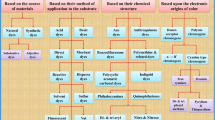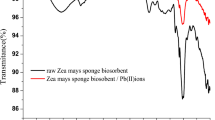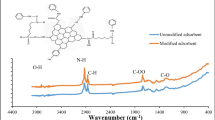Abstract
An unmodified natural adsorbent, Xanthium Strumarium, was explored for its decoloration potential for treatment of textile effluents. Batch mode experimentation was carried out to optimize several process parameters with the well characterized adsorbent. For proper assessment of optimized pathway of adsorption, adsorption isotherms were implemented to the experimental data using nonlinear method. Apart from coefficients of determination, three error analysis methods standard error (S.E.), Chi-square (χ2) statistic and residual mean square error were additionally used to determine the best fitted isothermal model for the system. Freundlich model was creditably fitted to the adsorption data with minimum errors and high R 2 values. The adsorption capacity obtained was 14.7, 15.2 and 18.7 mg g−1 at 30, 40 and 50 °C, respectively. Overall adsorption process was endothermic with positive enthalpy and entropy values. Kinetic study revealed adsorption to be a two stage process initially controlled by film diffusion followed by pseudosecond order as the rate administering step during adsorption. About 95 % decoloration was achieved in 60 min. High decoloration tendency of the opted adsorbent proved that it is an effective and cheap adsorbent for treatment of coloured effluents providing a good alternative to activated carbon.






Similar content being viewed by others
Abbreviations
- XSSH:
-
Xanthium Strumarium seed hull
- DR81:
-
Direct red 81
- FDA:
-
The food and drug administration
- SEM:
-
Scanning electron microscopy
- EDS:
-
Energy dispersive spectroscopy
- FTIR:
-
Fourier transform infrared spectroscopy
- XRD:
-
X-ray diffraction
- ASTM:
-
American Society for Testing and Materials
- RMSE:
-
Root-mean-square error
- S.E.:
-
Standard error
References
Ali, S. Z., Athar, M., Salman, M., & Din, M. I. (2011). Simultaneous removal of Pb(II), Cd(II) and Cu(II) from aqueous solutions by adsorption on Triticum aestivum—a green approach. Hydrology Current Research, 2(4), 118. doi:10.4172/2157-7587.1000118.
Ammari, T. G., Al-Labadi, I., Tahboub, A., & Ghrair, A. (2015). Assessment of unmodified wetland bio-waste: Shoots of Cyperus laevigatus, for cadmium adsorption from aqueous solutions. Process Safety and Environmental Protection, 95, 77–85. doi:10.1016/j.psep.2015.02.015.
Annadurai, G., Juang, R. S., & Lee, D. J. (2002). Use of cellulose-based wastes for adsorption of dyes from aqueous solutions. Journal of Hazardous Materials, 92(3), 263–274.
Ardejani, F. D., Badii, K., Limaee, N. Y., Shafaei, S. Z., & Mirhabibi, A. R. (2008). Adsorption of Direct red 80 dye from aqueous solution onto almond shells: Effect of pH, initial concentration and shell type. Journal of Hazardous Materials, 151(2), 730–737. doi:10.1016/j.jhazmat.2007.06.048.
Atar, N., & Olgun, A. (2009). Removal of basic and acid dyes from aqueous solutions by a waste containing boron impurity. Desalination, 249(1), 109–115. doi:10.1016/j.desal.2008.12.045.
Boyd, G. E., Adamson, A. W., & Myers, L. S, Jr. (1947). The exchange adsorption of ions from aqueous solutions by organic zeolites. II. Kinetics1. Journal of the American Chemical Society, 69(11), 2836–2848.
Chen, X. (2015). Modeling of experimental adsorption isotherm data. Information, 6(1), 14–22. doi:10.3390/info6010014.
Chithambararaj, A., & Bose, A. C. (2011). Investigation on structural, thermal, optical and sensing properties of meta-stable hexagonal MoO3 nanocrystals of one dimensional structure. Beilstein Journal of Nanotechnology, 2(1), 585–592. doi:10.3762/bjnano.6200.
Crini, G., & Badot, P. M. (2008). Application of chitosan, a natural aminopolysaccharide, for dye removal from aqueous solutions by adsorption processes using batch studies: A review of recent literature. Progress in Polymer Science, 33(4), 399–447.
Eren, E., & Afsin, B. (2008). Investigation of a basic dye adsorption from aqueous solution onto raw and pre-treated bentonite surfaces. Dyes and Pigments, 76(1), 220–225. doi:10.1016/j.dyepig.2006.08.019.
Gally, C.R., Lima, E.C., Reis, G.S.D., Puchana, M.J., Adebayo, M.A., Prola, L.D.T., & Djifon, P. (2014). Kinetics studies of removal of reactive red 120 textile dye from aqueous solutions using Jatropha curcas shells. Conference: X Encontro Brasileiro Sobre Adsorção, 27–30th April, Brazil. http://www2.unifesp.br/home_diadema/eba2014/br/resumos/R0124-2.PDF.
Gupta, V. K., Khamparia, S., Tyagi, I., Jaspal, D., & Malviya, A. (2015). Decolorization of mixture of dyes: A critical review. Global Journal of Environmental Science and Management, 1(1), 71–94. doi:10.7508/gjesm.2015.01.007.
Gupta, V. K., Mittal, A., Krishnan, L., & Gajbe, V. (2004). Adsorption kinetics and column operations for the removal and recovery of malachite green from wastewater using bottom ash. Separation and Purification Technology, 40(1), 87–96. doi:10.1016/j.seppur.2004.01.008.
Gürses, A., Karaca, S., Doğar, Ç., Bayrak, R., Açıkyıldız, M., & Yalçın, M. (2004). Determination of adsorptive properties of clay/water system: Methylene blue sorption. Journal of Colloid and Interface Science, 269(2), 310–314. doi:10.1016/j.jcis.2003.09.004.
Hall, K. R., Eagleton, L. C., Acrivos, A., & Vermeulen, T. (1966). Pore-and solid-diffusion kinetics in fixed-bed adsorption under constant-pattern conditions. Industrial and Engineering Chemistry Fundamentals, 5(2), 212–223.
Hamdaoui, O. (2006). Batch study of liquid-phase adsorption of methylene blue using cedar sawdust and crushed brick. Journal of Hazardous Materials, 135(1), 264–273. doi:10.1016/j.jhazmat.2005.11.062.
Hameed, B. H., Din, A. M., & Ahmad, A. L. (2007). Adsorption of methylene blue onto bamboo-based activated carbon: Kinetics and equilibrium studies. Journal of Hazardous Materials, 141(3), 819–825. doi:10.1016/j.jhazmat.2006.07.049.
Ho, Y. S., Chiu, W. T., & Wang, C. C. (2005). Regression analysis for the sorption isotherms of basic dyes on sugarcane dust. Bioresource technology, 96(11), 1285–1291. doi:10.1016/j.biortech.2004.10.021.
Ho, Y. S., Ng, J. C. Y., & McKay, G. (2001). Removal of lead (II) from effluents by sorption on peat using second-order kinetics. Separation Science and Technology, 36(2), 241–261. doi:10.1081/SS-100001077.
Hong, S., Wen, C., He, J., Gan, F., & Ho, Y. S. (2009). Adsorption thermodynamics of methylene blue onto bentonite. Journal of Hazardous Materials, 167(1), 630–633. doi:10.1016/j.jhazmat.2009.01.014.
Jain, N., Johnson, T. A., Kumar, A., Mishra, S., & Gupta, N. (2015). Biosorption of Cd (II) on jatropha fruit coat and seed coat. Environmental Monitoring and Assessment, 187(7), 1–12. doi:10.1007/s10661-015-4658-4.
Kamboj, A., & Saluja, A. K. (2010). Phytopharmacological review of Xanthium strumarium L. (Cocklebur). International Journal of Green Pharmacy, 4(3), 129–139.
Khambhaty, Y., Mody, K., Basha, S., & Jha, B. (2009). Kinetics, equilibrium and thermodynamic studies on biosorption of hexavalent chromium by dead fungal biomass of marine Aspergillus niger. Chemical Engineering Journal, 145(3), 489–495. doi:10.1016/j.cej.2008.05.002.
Mezaguer, M., El Hayet Kamel, N., Lounici, H., & Kamel, Z. (2013). Characterization and properties of Pleurotus mutilus fungal biomass as adsorbent of the removal of uranium (VI) from uranium leachate. Journal of Radioanalytical and Nuclear Chemistry, 295(1), 393–403. doi:10.1007/s10967-012-1911-y.
Mittal, A., Kaur, D., Malviya, A., Mittal, J., & Gupta, V. K. (2009). Adsorption studies on the removal of coloring agent phenol red from wastewater using waste materials as adsorbents. Journal of Colloid and Interface Science, 337(2), 345–354. doi:10.1016/j.jcis.2009.05.016.
Mittal, A., Thakur, V., Mittal, J., & Vardhan, H. (2014). Process development for the removal of hazardous anionic azo dye Congo red from wastewater by using hen feather as potential adsorbent. Desalination and Water Treatment, 52(1–3), 227–237. doi:10.1080/19443994.2013.785030.
Namasivayam, C., & Kavitha, D. (2002). Removal of Congo Red from water by adsorption onto activated carbon prepared from coir pith, an agricultural solid waste. Dyes and Pigments, 54(1), 47–58. doi:10.1016/S0143-7208(02)00025-6.
Namasivayam, C., Prabha, D., & Kumutha, M. (1998). Removal of direct red and acid brilliant blue by adsorption on to banana pith. Bioresource Technology, 64(1), 77–79.
Özcan, A. S., Erdem, B., & Özcan, A. (2004). Adsorption of Acid Blue 193 from aqueous solutions onto Na–bentonite and DTMA–bentonite. Journal of Colloid and Interface Science, 280(1), 44–54. doi:10.1016/j.jcis.2004.07.035.
Özcan, A. S., Erdem, B., & Özcan, A. (2005). Adsorption of Acid Blue 193 from aqueous solutions onto BTMA-bentonite. Colloids and Surfaces A: Physicochemical and Engineering Aspects, 266(1), 73–81. doi:10.1016/j.colsurfa.2005.06.001.
Pavan, F. A., Lima, E. C., Dias, S. L., & Mazzocato, A. C. (2008). Methylene blue biosorption from aqueous solutions by yellow passion fruit waste. Journal of Hazardous Materials, 150(3), 703–712. doi:10.1016/j.jhazmat.2007.05.023.
Robinson, T., McMullan, G., Marchant, R., & Nigam, P. (2001). Remediation of dyes in textile effluent: A critical review on current treatment technologies with a proposed alternative. Bioresource Technology, 77(3), 247–255.
Roy, A., Chakraborty, S., Kundu, S. P., Adhikari, B., & Majumder, S. B. (2012). Adsorption of anionic-azo dye from aqueous solution by lignocellulose-biomass jute fiber: Equilibrium, kinetics, and thermodynamics study. Industrial and Engineering Chemistry Research, 51(37), 12095–12106. doi:10.1021/ie301708e.
Samarghandi, M. R., Hadi, M., Moayedi, S., & Askari, F. B. (2010). Two-parameter isotherms of methyl orange sorption by pinecone derived activated carbon. Iranian Journal Environmental Health Science Engineering, 6(4), 285–294.
Sayğılı, H., Güzel, F., & Önal, Y. (2015). Conversion of grape industrial processing waste to activated carbon sorbent and its performance in cationic and anionic dyes adsorption. Journal of Cleaner Production, 93, 84–93. doi:10.1016/j.jclepro.2015.01.009.
Sivaraj, R., Namasivayam, C., & Kadirvelu, K. (2001). Orange peel as an adsorbent in the removal of acid violet 17 (acid dye) from aqueous solutions. Waste Management, 21(1), 105–110. doi:10.1016/S0956-053X(00)00076-3.
Su, Y., Zhao, B., Xiao, W., & Han, R. (2013). Adsorption behavior of light green anionic dye using cationic surfactant-modified wheat straw in batch and column mode. Environmental Science and Pollution Research, 20(8), 5558–5568. doi:10.1007/s11356-013-1571-7.
Subha, R., & Namasivayam, C. (2009). Zinc chloride activated coir pith carbon as low cost adsorbent for removal of 2, 4-dichlorophenol: Equilibrium and kinetic studies. Indian Journal of Chemical Technology, 16(6), 471–479.
Tabak, A., Eren, E., Afsin, B., & Caglar, B. (2009). Determination of adsorptive properties of a Turkish Sepiolite for removal of Reactive Blue 15 anionic dye from aqueous solutions. Journal of Hazardous Materials, 161(2), 1087–1094. doi:10.1016/j.jhazmat.2008.04.062.
Wang, S., Li, H., & Xu, L. (2006). Application of zeolite MCM-22 for basic dye removal from wastewater. Journal of Colloid and Interface Science, 295(1), 71–78. doi:10.1016/j.jcis.2005.08.006.
Xue, L. M., Zhang, Q. Y., Han, P., Jiang, Y. P., Yan, R. D., Wang, Y., et al. (2014). Hepatotoxic constituents and toxicological mechanism of Xanthium strumarium L. fruits. Journal of Ethnopharmacology, 152(2), 272–282. doi:10.1016/j.jep.2013.12.024.
Acknowledgement
This work was supported by the Symbiosis International University, Pune, India, under Junior Research Fellowship Scheme.
Author information
Authors and Affiliations
Corresponding author
Rights and permissions
About this article
Cite this article
Khamparia, S., Jaspal, D.K. Evaluation of decoloration potential of Xanthium Strumarium seed hull for adsorption of Direct red 81 in aqueous solution. Environ Dev Sustain 19, 1933–1951 (2017). https://doi.org/10.1007/s10668-016-9836-1
Received:
Accepted:
Published:
Issue Date:
DOI: https://doi.org/10.1007/s10668-016-9836-1




